
Harris Chain Bass Fishing Tactics
All lakes and fresh water bodies of water have observable characteristics that indicate which bass fishing tactics will be
successful. When approaching a new fishing area, recognizing and correctly analyzing water color to dictate your choice of technique
is key to your success.
The Harris Chain contains a very wide and diverse range of water colors. Until recently, the water color
in main lake areas of the Harris Chain was stained and prone to algae blooms in the summer months. Restoration efforts and time have
begun to clear the water causing eel, pepper grass and hydrilla to proliferate. Budgetary problems and urgings from anglers and
fisheries biologists have for now reduced the level and potency of chemical treatments. Only time will tell if the Harris Chain bass
fishery will have a chance to realize it's true potential or the Water Authority will return to their old methods of weed control. No
one wants the Harris Chain to totally top out with Hydrilla mats, but in our opinion a zero tolerance policy makes no economic or
environmental sense.
Best Stained Water Tactics
Our definition of stained water is water where you can not see a light colored lure deeper than 18 inches. Many areas of the Harris Chain still meet this definition. This actually makes bass easier to
locate and catch as bass in these areas are shallow and hold close to cover. Noisy lures are effective and multiple presentations to
the same spot are required to get the fish's attention. These tactics are also effective in fishing bass in heavy cover even when
the water is clear. Here are three tactics you can use to catch bass in stained water.
Crankbaits
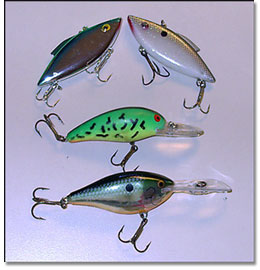 Nothing works better at finding stained water bass than a noisy crankbait. You need three basic colors; a chrome pattern, a shad pattern and a chartreuse
pattern. Remember to keep the lure as close to cover as you can and make multiple casts to the same spot. Run them through or along the
side of grass beds, lily pads, stickups and boat docks. Deflecting your lure off cover is very effective as it can trigger an inactive
bass to strike. Giving the lure some action by stopping or jerking your rod occasionally mimics a deflection. If you're worried about
getting snagged, use heavier line. This will make your lure run shallower and allow you to pull the lure out instead of moving in to
retrieve your lure. In recent years, the lakes have cleared considerably making offshore cranking a viable option. Trolling or
casting the deep offshore ditch in front of Yalaha is especially productive in Summer. Keep moving and make note of the
characteristics of where you catch each fish. If you're observant and use your head you can catch a pattern and run the lakes for a
nice limit.
Nothing works better at finding stained water bass than a noisy crankbait. You need three basic colors; a chrome pattern, a shad pattern and a chartreuse
pattern. Remember to keep the lure as close to cover as you can and make multiple casts to the same spot. Run them through or along the
side of grass beds, lily pads, stickups and boat docks. Deflecting your lure off cover is very effective as it can trigger an inactive
bass to strike. Giving the lure some action by stopping or jerking your rod occasionally mimics a deflection. If you're worried about
getting snagged, use heavier line. This will make your lure run shallower and allow you to pull the lure out instead of moving in to
retrieve your lure. In recent years, the lakes have cleared considerably making offshore cranking a viable option. Trolling or
casting the deep offshore ditch in front of Yalaha is especially productive in Summer. Keep moving and make note of the
characteristics of where you catch each fish. If you're observant and use your head you can catch a pattern and run the lakes for a
nice limit.
Spinnerbaits
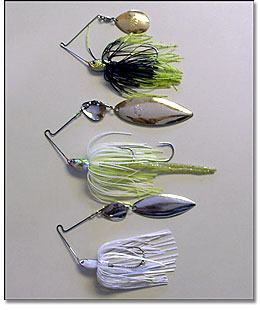 Year
round a spinnerbait is one of my go-to baits on the Harris Chain. Fish slowly around pads, grass points, boat docks and along canal ledges, keeping your lure as close to cover as possible. Many of
these bass will be over 5 pounds, so you want to use heavier tackle. The most important thing to remember when fishing these lakes is to
slow down and fish everything at least twice. The standard colors of white and chartreuse work well. On overcast days, try black and
chartreuse. Both gold and silver blades catch bass in Florida, but you need to experiment to find out what they want on a given day.
Bait size is sometimes critical. I carry an assortment of spinnerbaits from 1/4 to 3/4 oz. Some days, a change in blade size
can make a big difference. If there is a lot of tournament pressure, downsizing your blades is a good way to finesse these baits and
attract more strikes. For some reason, I have never had a lot of success "bulging" a spinner bait in the Harris Chain. Our bass seem
to prefer slower presentations, at least in my boat. These baits are deadly on bedding bass and they catch quality fish. My favorite
tactic in the winter is to "run and gun" the lakes with a spinnerbait. Done right, you can pick up a nice limit in a day of
fishing and you might catch a giant.
Year
round a spinnerbait is one of my go-to baits on the Harris Chain. Fish slowly around pads, grass points, boat docks and along canal ledges, keeping your lure as close to cover as possible. Many of
these bass will be over 5 pounds, so you want to use heavier tackle. The most important thing to remember when fishing these lakes is to
slow down and fish everything at least twice. The standard colors of white and chartreuse work well. On overcast days, try black and
chartreuse. Both gold and silver blades catch bass in Florida, but you need to experiment to find out what they want on a given day.
Bait size is sometimes critical. I carry an assortment of spinnerbaits from 1/4 to 3/4 oz. Some days, a change in blade size
can make a big difference. If there is a lot of tournament pressure, downsizing your blades is a good way to finesse these baits and
attract more strikes. For some reason, I have never had a lot of success "bulging" a spinner bait in the Harris Chain. Our bass seem
to prefer slower presentations, at least in my boat. These baits are deadly on bedding bass and they catch quality fish. My favorite
tactic in the winter is to "run and gun" the lakes with a spinnerbait. Done right, you can pick up a nice limit in a day of
fishing and you might catch a giant.
Flipping and Pitching
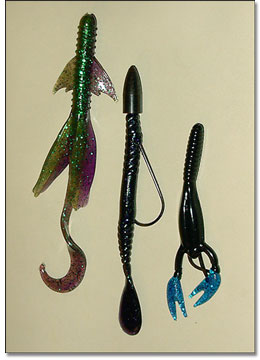 When bass are relating to heavy cover, the flipping and pitching technique is very effective on Harris Chain bass. It is also the
best way to specifically target larger bass. Any soft plastic can be used to flip cover. The most popular Harris Chain colors are grape,
junebug, and black with a blue tail. This tactic is primarily used in shallow water cover from 3 to 6 feet in depth. I use 25 pound
Trilene Big Game mono for flipping, a bait casting reel and a 7 1/2 foot heavy action rod. The reel doesn't matter much as long as the
spool revolves freely and the reel does not break down. I will drop down to lighter line if the water is extremely clear. It pays to
experiment with lure size and sinker weight. Some days the fish want big lures and heavy weights and other days they want a 4" worm and a
light weight. So far, we don't have heavy mats to punch through, so flipping weights are usually in the 1/8 to 3/8 oz. range. It is best
to peg your weight to the worm by using a screw-in weight, toothpick or commercial sinker stop. It takes practice and patience to flip for bass,
but the rewards are worth the effort. If you have never done this type of fishing before, it is best to ride with a good flipper and
observe how it's done. This will also bring up your confidence level and keep you in the game. When I first started flipping I left all
my other tackle as home so I wouldn't be tempted to give up and try something else. The majority of my Harris Chain bass over 10 pounds
have been caught using the flipping technique and yours can be too. For more information about flipping for Harris Chain bass
click here.
When bass are relating to heavy cover, the flipping and pitching technique is very effective on Harris Chain bass. It is also the
best way to specifically target larger bass. Any soft plastic can be used to flip cover. The most popular Harris Chain colors are grape,
junebug, and black with a blue tail. This tactic is primarily used in shallow water cover from 3 to 6 feet in depth. I use 25 pound
Trilene Big Game mono for flipping, a bait casting reel and a 7 1/2 foot heavy action rod. The reel doesn't matter much as long as the
spool revolves freely and the reel does not break down. I will drop down to lighter line if the water is extremely clear. It pays to
experiment with lure size and sinker weight. Some days the fish want big lures and heavy weights and other days they want a 4" worm and a
light weight. So far, we don't have heavy mats to punch through, so flipping weights are usually in the 1/8 to 3/8 oz. range. It is best
to peg your weight to the worm by using a screw-in weight, toothpick or commercial sinker stop. It takes practice and patience to flip for bass,
but the rewards are worth the effort. If you have never done this type of fishing before, it is best to ride with a good flipper and
observe how it's done. This will also bring up your confidence level and keep you in the game. When I first started flipping I left all
my other tackle as home so I wouldn't be tempted to give up and try something else. The majority of my Harris Chain bass over 10 pounds
have been caught using the flipping technique and yours can be too. For more information about flipping for Harris Chain bass
click here.
Best Clear Water Tactics
Many of the residential canals in the Harris Chain contain clear water. Bass in clear water rely
more on their eyes to find food, which means good top water action. Bedding bass are especially susceptible to top water lures. As a
rule of thumb, minimum water temperatures in the mid to high sixties are necessary for good top water fishing. As the lakes have cleared,
Harris Chain top water fishing has greatly improved. The following are my favorite techniques for bass fishing in clear water Florida
lakes.
Top Water Plugs
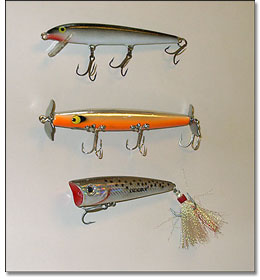 Top water tactics work great in Florida's clearer lakes and backwater areas such as the Harris
Chain residential canals. The most popular Florida top water baits are the Devil's Horse, the Rapala Minnow, the Pop-R and the many
other variations on these great baits. Because of the relatively warm water in Florida, it is best to work them slightly faster than
you might in the north part of the country. Generally, bass caught on a top water lure will be larger than those caught using other
techniques. The key is to get the bait as close to the fish as possible, which means very accurate casting. The best top water
action is generally on warmer days. An approaching cold front or just before or following a summer thunderstorm can also trigger a
top water bite. Anyone looking into my tackle box will notice a top tray full of Devil's Horse baits. I love this bait and have a
collection of out-of-production lures that still catch an amazing number of quality bass. The production colors work just as well, but
I enjoy going "old school" more than most younger anglers.
Top water tactics work great in Florida's clearer lakes and backwater areas such as the Harris
Chain residential canals. The most popular Florida top water baits are the Devil's Horse, the Rapala Minnow, the Pop-R and the many
other variations on these great baits. Because of the relatively warm water in Florida, it is best to work them slightly faster than
you might in the north part of the country. Generally, bass caught on a top water lure will be larger than those caught using other
techniques. The key is to get the bait as close to the fish as possible, which means very accurate casting. The best top water
action is generally on warmer days. An approaching cold front or just before or following a summer thunderstorm can also trigger a
top water bite. Anyone looking into my tackle box will notice a top tray full of Devil's Horse baits. I love this bait and have a
collection of out-of-production lures that still catch an amazing number of quality bass. The production colors work just as well, but
I enjoy going "old school" more than most younger anglers.
The Wacky Worm
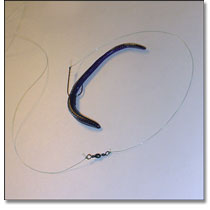 The wacky worm is a clear water technique so deadly that many Florida tournament anglers kept it to themselves
for a long time. The wacky rig is a straight tailed worm fished on a light spinning outfit with no weight or only a swivel above the bait
for weight. The best time for wacky worm fishing is spring but you can catch bass on it year round in Florida. This rig works because
it falls very slow and natural. Also, the worm doesn't dig in and stir up mucky bottom debris. Cast the worm along the sides of lily
pads or next to steep canal banks and let it fall slowly under it's own weight. Hits will generally be light or your worm will just
start to move off slowly. This rig is deadly on bedding bass. Sometimes this technique will catch bass when nothing else works. I
use Zoom trick worms for this technique, but any straight tailed worm will work. I have fished with Tournament Pros who fish a Senko
wacky style with great results. More tournaments have been won in Florida using this technique than anyone imagines.
The wacky worm is a clear water technique so deadly that many Florida tournament anglers kept it to themselves
for a long time. The wacky rig is a straight tailed worm fished on a light spinning outfit with no weight or only a swivel above the bait
for weight. The best time for wacky worm fishing is spring but you can catch bass on it year round in Florida. This rig works because
it falls very slow and natural. Also, the worm doesn't dig in and stir up mucky bottom debris. Cast the worm along the sides of lily
pads or next to steep canal banks and let it fall slowly under it's own weight. Hits will generally be light or your worm will just
start to move off slowly. This rig is deadly on bedding bass. Sometimes this technique will catch bass when nothing else works. I
use Zoom trick worms for this technique, but any straight tailed worm will work. I have fished with Tournament Pros who fish a Senko
wacky style with great results. More tournaments have been won in Florida using this technique than anyone imagines.
All Water Clarities - Carolina Rig
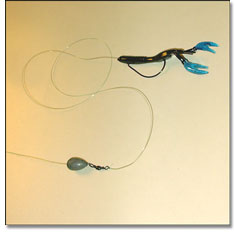 The Carolina rig is an old tactic, but it works so well in Florida I included it in it's own section.
The rig is made with an egg sinker, a swivel, a 18"-36" leader and a worm hook. The lure can be any soft plastic but generally it's a
finesse worm, a lizard or a small craw. The rig hugs the bottom and telegraphs the bottom composition and contour to the angler
perfectly. This rig works especially well in finding offshore rock piles and shell beds. If you cast out this rig and on the retrieve
you feel the bump bump of the sinker against rocks or any hard cover, you are about to get bit. This is also a great technique to
use in fishing deep grass beds, just adjust the sinker weight to compensate for the weeds. This is a technique that will work
anywhere in Florida where the bottom is hard enough to fish it. Many times you can locate bass with a Carolina rig that the majority of
the fisherman don't even know exist.
The Carolina rig is an old tactic, but it works so well in Florida I included it in it's own section.
The rig is made with an egg sinker, a swivel, a 18"-36" leader and a worm hook. The lure can be any soft plastic but generally it's a
finesse worm, a lizard or a small craw. The rig hugs the bottom and telegraphs the bottom composition and contour to the angler
perfectly. This rig works especially well in finding offshore rock piles and shell beds. If you cast out this rig and on the retrieve
you feel the bump bump of the sinker against rocks or any hard cover, you are about to get bit. This is also a great technique to
use in fishing deep grass beds, just adjust the sinker weight to compensate for the weeds. This is a technique that will work
anywhere in Florida where the bottom is hard enough to fish it. Many times you can locate bass with a Carolina rig that the majority of
the fisherman don't even know exist.
If you would like to suggest other techniques, have comments or questions, please don't hesitate to
contact me.



 Nothing works better at finding stained water bass than a noisy crankbait. You need three basic colors; a chrome pattern, a shad pattern and a chartreuse
pattern. Remember to keep the lure as close to cover as you can and make multiple casts to the same spot. Run them through or along the
side of grass beds, lily pads, stickups and boat docks. Deflecting your lure off cover is very effective as it can trigger an inactive
bass to strike. Giving the lure some action by stopping or jerking your rod occasionally mimics a deflection. If you're worried about
getting snagged, use heavier line. This will make your lure run shallower and allow you to pull the lure out instead of moving in to
retrieve your lure. In recent years, the lakes have cleared considerably making offshore cranking a viable option. Trolling or
casting the deep offshore ditch in front of Yalaha is especially productive in Summer. Keep moving and make note of the
characteristics of where you catch each fish. If you're observant and use your head you can catch a pattern and run the lakes for a
nice limit.
Nothing works better at finding stained water bass than a noisy crankbait. You need three basic colors; a chrome pattern, a shad pattern and a chartreuse
pattern. Remember to keep the lure as close to cover as you can and make multiple casts to the same spot. Run them through or along the
side of grass beds, lily pads, stickups and boat docks. Deflecting your lure off cover is very effective as it can trigger an inactive
bass to strike. Giving the lure some action by stopping or jerking your rod occasionally mimics a deflection. If you're worried about
getting snagged, use heavier line. This will make your lure run shallower and allow you to pull the lure out instead of moving in to
retrieve your lure. In recent years, the lakes have cleared considerably making offshore cranking a viable option. Trolling or
casting the deep offshore ditch in front of Yalaha is especially productive in Summer. Keep moving and make note of the
characteristics of where you catch each fish. If you're observant and use your head you can catch a pattern and run the lakes for a
nice limit. Year
round a spinnerbait is one of my go-to baits on the Harris Chain. Fish slowly around pads, grass points, boat docks and along canal ledges, keeping your lure as close to cover as possible. Many of
these bass will be over 5 pounds, so you want to use heavier tackle. The most important thing to remember when fishing these lakes is to
slow down and fish everything at least twice. The standard colors of white and chartreuse work well. On overcast days, try black and
chartreuse. Both gold and silver blades catch bass in Florida, but you need to experiment to find out what they want on a given day.
Bait size is sometimes critical. I carry an assortment of spinnerbaits from 1/4 to 3/4 oz. Some days, a change in blade size
can make a big difference. If there is a lot of tournament pressure, downsizing your blades is a good way to finesse these baits and
attract more strikes. For some reason, I have never had a lot of success "bulging" a spinner bait in the Harris Chain. Our bass seem
to prefer slower presentations, at least in my boat. These baits are deadly on bedding bass and they catch quality fish. My favorite
tactic in the winter is to "run and gun" the lakes with a spinnerbait. Done right, you can pick up a nice limit in a day of
fishing and you might catch a giant.
Year
round a spinnerbait is one of my go-to baits on the Harris Chain. Fish slowly around pads, grass points, boat docks and along canal ledges, keeping your lure as close to cover as possible. Many of
these bass will be over 5 pounds, so you want to use heavier tackle. The most important thing to remember when fishing these lakes is to
slow down and fish everything at least twice. The standard colors of white and chartreuse work well. On overcast days, try black and
chartreuse. Both gold and silver blades catch bass in Florida, but you need to experiment to find out what they want on a given day.
Bait size is sometimes critical. I carry an assortment of spinnerbaits from 1/4 to 3/4 oz. Some days, a change in blade size
can make a big difference. If there is a lot of tournament pressure, downsizing your blades is a good way to finesse these baits and
attract more strikes. For some reason, I have never had a lot of success "bulging" a spinner bait in the Harris Chain. Our bass seem
to prefer slower presentations, at least in my boat. These baits are deadly on bedding bass and they catch quality fish. My favorite
tactic in the winter is to "run and gun" the lakes with a spinnerbait. Done right, you can pick up a nice limit in a day of
fishing and you might catch a giant. When bass are relating to heavy cover, the flipping and pitching technique is very effective on Harris Chain bass. It is also the
best way to specifically target larger bass. Any soft plastic can be used to flip cover. The most popular Harris Chain colors are grape,
junebug, and black with a blue tail. This tactic is primarily used in shallow water cover from 3 to 6 feet in depth. I use 25 pound
Trilene Big Game mono for flipping, a bait casting reel and a 7 1/2 foot heavy action rod. The reel doesn't matter much as long as the
spool revolves freely and the reel does not break down. I will drop down to lighter line if the water is extremely clear. It pays to
experiment with lure size and sinker weight. Some days the fish want big lures and heavy weights and other days they want a 4" worm and a
light weight. So far, we don't have heavy mats to punch through, so flipping weights are usually in the 1/8 to 3/8 oz. range. It is best
to peg your weight to the worm by using a screw-in weight, toothpick or commercial sinker stop. It takes practice and patience to flip for bass,
but the rewards are worth the effort. If you have never done this type of fishing before, it is best to ride with a good flipper and
observe how it's done. This will also bring up your confidence level and keep you in the game. When I first started flipping I left all
my other tackle as home so I wouldn't be tempted to give up and try something else. The majority of my Harris Chain bass over 10 pounds
have been caught using the flipping technique and yours can be too. For more information about flipping for Harris Chain bass
When bass are relating to heavy cover, the flipping and pitching technique is very effective on Harris Chain bass. It is also the
best way to specifically target larger bass. Any soft plastic can be used to flip cover. The most popular Harris Chain colors are grape,
junebug, and black with a blue tail. This tactic is primarily used in shallow water cover from 3 to 6 feet in depth. I use 25 pound
Trilene Big Game mono for flipping, a bait casting reel and a 7 1/2 foot heavy action rod. The reel doesn't matter much as long as the
spool revolves freely and the reel does not break down. I will drop down to lighter line if the water is extremely clear. It pays to
experiment with lure size and sinker weight. Some days the fish want big lures and heavy weights and other days they want a 4" worm and a
light weight. So far, we don't have heavy mats to punch through, so flipping weights are usually in the 1/8 to 3/8 oz. range. It is best
to peg your weight to the worm by using a screw-in weight, toothpick or commercial sinker stop. It takes practice and patience to flip for bass,
but the rewards are worth the effort. If you have never done this type of fishing before, it is best to ride with a good flipper and
observe how it's done. This will also bring up your confidence level and keep you in the game. When I first started flipping I left all
my other tackle as home so I wouldn't be tempted to give up and try something else. The majority of my Harris Chain bass over 10 pounds
have been caught using the flipping technique and yours can be too. For more information about flipping for Harris Chain bass
 Top water tactics work great in Florida's clearer lakes and backwater areas such as the Harris
Chain residential canals. The most popular Florida top water baits are the Devil's Horse, the Rapala Minnow, the Pop-R and the many
other variations on these great baits. Because of the relatively warm water in Florida, it is best to work them slightly faster than
you might in the north part of the country. Generally, bass caught on a top water lure will be larger than those caught using other
techniques. The key is to get the bait as close to the fish as possible, which means very accurate casting. The best top water
action is generally on warmer days. An approaching cold front or just before or following a summer thunderstorm can also trigger a
top water bite. Anyone looking into my tackle box will notice a top tray full of Devil's Horse baits. I love this bait and have a
collection of out-of-production lures that still catch an amazing number of quality bass. The production colors work just as well, but
I enjoy going "old school" more than most younger anglers.
Top water tactics work great in Florida's clearer lakes and backwater areas such as the Harris
Chain residential canals. The most popular Florida top water baits are the Devil's Horse, the Rapala Minnow, the Pop-R and the many
other variations on these great baits. Because of the relatively warm water in Florida, it is best to work them slightly faster than
you might in the north part of the country. Generally, bass caught on a top water lure will be larger than those caught using other
techniques. The key is to get the bait as close to the fish as possible, which means very accurate casting. The best top water
action is generally on warmer days. An approaching cold front or just before or following a summer thunderstorm can also trigger a
top water bite. Anyone looking into my tackle box will notice a top tray full of Devil's Horse baits. I love this bait and have a
collection of out-of-production lures that still catch an amazing number of quality bass. The production colors work just as well, but
I enjoy going "old school" more than most younger anglers. The wacky worm is a clear water technique so deadly that many Florida tournament anglers kept it to themselves
for a long time. The wacky rig is a straight tailed worm fished on a light spinning outfit with no weight or only a swivel above the bait
for weight. The best time for wacky worm fishing is spring but you can catch bass on it year round in Florida. This rig works because
it falls very slow and natural. Also, the worm doesn't dig in and stir up mucky bottom debris. Cast the worm along the sides of lily
pads or next to steep canal banks and let it fall slowly under it's own weight. Hits will generally be light or your worm will just
start to move off slowly. This rig is deadly on bedding bass. Sometimes this technique will catch bass when nothing else works. I
use Zoom trick worms for this technique, but any straight tailed worm will work. I have fished with Tournament Pros who fish a Senko
wacky style with great results. More tournaments have been won in Florida using this technique than anyone imagines.
The wacky worm is a clear water technique so deadly that many Florida tournament anglers kept it to themselves
for a long time. The wacky rig is a straight tailed worm fished on a light spinning outfit with no weight or only a swivel above the bait
for weight. The best time for wacky worm fishing is spring but you can catch bass on it year round in Florida. This rig works because
it falls very slow and natural. Also, the worm doesn't dig in and stir up mucky bottom debris. Cast the worm along the sides of lily
pads or next to steep canal banks and let it fall slowly under it's own weight. Hits will generally be light or your worm will just
start to move off slowly. This rig is deadly on bedding bass. Sometimes this technique will catch bass when nothing else works. I
use Zoom trick worms for this technique, but any straight tailed worm will work. I have fished with Tournament Pros who fish a Senko
wacky style with great results. More tournaments have been won in Florida using this technique than anyone imagines. The Carolina rig is an old tactic, but it works so well in Florida I included it in it's own section.
The rig is made with an egg sinker, a swivel, a 18"-36" leader and a worm hook. The lure can be any soft plastic but generally it's a
finesse worm, a lizard or a small craw. The rig hugs the bottom and telegraphs the bottom composition and contour to the angler
perfectly. This rig works especially well in finding offshore rock piles and shell beds. If you cast out this rig and on the retrieve
you feel the bump bump of the sinker against rocks or any hard cover, you are about to get bit. This is also a great technique to
use in fishing deep grass beds, just adjust the sinker weight to compensate for the weeds. This is a technique that will work
anywhere in Florida where the bottom is hard enough to fish it. Many times you can locate bass with a Carolina rig that the majority of
the fisherman don't even know exist.
The Carolina rig is an old tactic, but it works so well in Florida I included it in it's own section.
The rig is made with an egg sinker, a swivel, a 18"-36" leader and a worm hook. The lure can be any soft plastic but generally it's a
finesse worm, a lizard or a small craw. The rig hugs the bottom and telegraphs the bottom composition and contour to the angler
perfectly. This rig works especially well in finding offshore rock piles and shell beds. If you cast out this rig and on the retrieve
you feel the bump bump of the sinker against rocks or any hard cover, you are about to get bit. This is also a great technique to
use in fishing deep grass beds, just adjust the sinker weight to compensate for the weeds. This is a technique that will work
anywhere in Florida where the bottom is hard enough to fish it. Many times you can locate bass with a Carolina rig that the majority of
the fisherman don't even know exist.